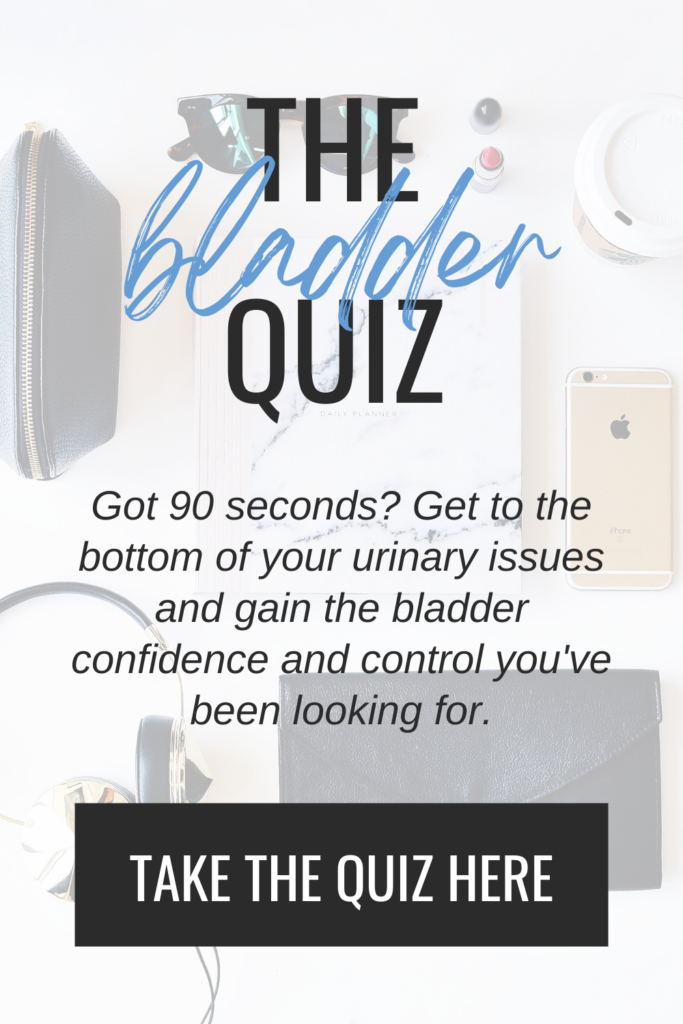One in three women experience bladder issues like urinary leakage, and if you’re in this statistic, you maaaaaay also notice this tends to get worse right before and during the first few days of your menstrual cycle. While you might be wondering what Mother Nature was thinking with a cruel joke like this, the monthly assault of period symptoms (helloooooo cramps, headaches, bloating, fatigue, etc.) plus annoying accidents don’t have to be your standard.
RELATED POST: 7 Holistic Menstrual Cycle Hacks to Help You Thrive During Your Period
You may have heard me mention a time or ten that common and normal are two [very] different things. The unfortunate reason these words get mixed up and misused (especially around women’s health issues) is because females are “hard” to research…thank you, hormones, so time and money are spent on other studies and we’re left making do, carrying on, and telling generation after generation that this is just the way it is.
So period pain and problems?…They’re common, but not normal. Urine leakage?…Same, same. And you certainly don’t have to suffer unnecessarily when the two are combined. There are three overarching reasons for all of the above during menstruation, and once you identify the “why”, reducing and even eliminating these symptoms is actually quite easy.
CRAMPS = TIGHT PELVIC FLOOR = WEAKNESS
Menstrual cramps are a normal and necessary part of your period as the uterus and pelvic floor muscles must contract to shed the endometrial lining. When the pelvic floor becomes tense, the muscles that control your bladder become weak (because tense does not equal strong, it’s actually quite the opposite) and leakage is more likely to occur.
I like to think of the pelvic floor like a fist. Your hand should be able to make a fist, but it shouldn’t be stuck in a fist. A hand stuck in a fist is painful, weak, and dysfunctional— and the pelvic floor is no different (hence the leakage and pain with periods).
Incontinence doesn’t have to be a part of your period just like cramps don’t have to be painful (peep that link to my top menstrual cycle hacks above). In fact, learning to relax the pelvic floor muscles is a trick that you need up your sleep to manage both correctly and confidently. Download this guide for a deep-dive into my favorite pelvic floor relaxation strategies that work like a charm.
RELATED POST: My Daily Pelvic Floor Relaxation Routine + Why You Might Want to Try It Too
Whether you choose to do the stretches, piston breathing, “let it go” technique, or all of the above (it will all make sense once you grab that download…I promise), performing these strategies before, during, and after your period are my secret weapon for nearly all pelvic floor issues, but espeeeeecially pain and leakage.
LOW ESTROGEN = LESS URETHRA ELASTICITY
Right before your period starts, estrogen and progesterone drop. This sudden shift in hormones signals the cascading events of menstruation and many of the symptoms that follow. Because estrogen is responsible for the elasticity in your muscles, ligaments, and tendons, not only do we tend to become a little more accident-prone during our periods, but urethra strength and coordination are also compromised leading to more urinary leakage.
We can’t prevent this hormone change (nor do we want to…), but we can be extra diligent about setting the urethra, bladder and pelvic floor up for success during this time. I’m not a proponent of repetitive kegels during your period because of the muscle tightness already present during menstruation, but there are other ways to promote urethra function without contracting your pelvic floor hundreds of times a day.
Because low estrogen levels exacerbate limitations in urethra strength, coordination, and control, you need to support your body by being a bit more proactive during menstruation. Want to know which specific bladder strategies you should spend your time on? Take this quiz to find out exactly what your bladder needs. There are different kinds of urine leakage, and as you may guess…different exercises to help with each.
FLUID RETENTION + UTERINE SWELLING = INCREASED BLADDER PRESSURE
Blame it on those hormones again, but the sudden drop in progesterone prior to your period causes fluid retention. Add in the fact that the uterus swells to almost double the size during menstruation, and this combo creates increased bladder pressure, which can result in more leakage.
While we can’t inhibit uterine swelling, you can limit bloating and fluid retention by drinking adequate water and doing it in a way that’s best for your body. Eating foods that your gut can easily process will also help prevent bloating and provide relief to your bladder.
As a pelvic rehab therapist, my favorite way to reduce bladder pressure is by maintaining good, neutral pelvic posture. Many women tend to sit and stand in an anterior pelvic tilt, sticking their breasts out the front and booty out the back. This position puts pressure anteriorly on the bladder, intensifying the pressure that’s already there from uterine swelling, fluid retention, and bloat.
Posture might be the last thing you want to think about while on your period, but the pelvic floor is strongest when you’re in neutral and this in itself can eliminate any bladder issues that arise. To find neutral pelvic posture, align your ears, shoulders, hips, and ankles; think about lightly engaging your core and glutes to get here. I like to set a cue to remind me to check in with my posture often, such as every time I get a text or email.
While these mechanisms behind increased urine leakage during menstruation make sense, let me remind you again that common does not mean normal, and with a bit of mindfulness and proactivity in the guidance above, you should find yourself sailing through your period with little to no accidents.
We have to trust that Mother Nature knows what she was doing, and I’ve become a firm believer that menstruation can be a ~magical~ time when you slow down long enough to listen to your body’s needs and actually give it what it’s asking for. Urine leakage while on your period is your pelvic floor begging for support, and you now have the tools to satisfy it. By practicing these techniques throughout the month, period or not, you’ll be a pro once the beginning of your cycle rolls around.
– Amanda
Disclaimer: The content provided here does not constitute medical advice, nor is it a substitute for personalized healthcare. If you have concerns about a medical condition, diagnosis, or treatment, you should consult with a licensed healthcare professional.



















